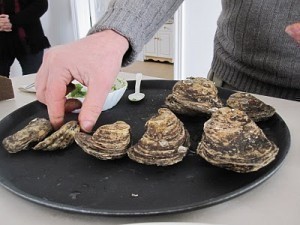Oyster Sizes
The size of the oyster ranges from 3 inches for the small ones  and 4 to 5 inches for the medium types. Any oysters over 5 inches are considered large. The maximum size is 14 inches (36 cm). They typically weigh 8 ounces.
and 4 to 5 inches for the medium types. Any oysters over 5 inches are considered large. The maximum size is 14 inches (36 cm). They typically weigh 8 ounces.
Classification
The oysters are included in the mollusk family (genus Ostrea; subfamily Ostreidea).  The term is also used for the various types of bivalve mollusks. These creatures can be found in brackish and marine habitation.
The term is also used for the various types of bivalve mollusks. These creatures can be found in brackish and marine habitation.
General Description
These are creatures that reside in a shell. They connect themselves to coral reefs and rocks in the seas. These oysters are typically clustered together. The colors vary, with some brown and others white or green.
Whatever the size of the oyster is, it has three major organs: digestive, reproductive and respiratory. These oysters are noted for their ability to flourish under various water conditions.
If the oyster is thrown ashore during low tide, the shell assists in surviving when out of its watery home. There is liquid in the shell, providing it food and nutrients.
As the oyster attains maturity, it hooks up to a hard surface. The shape of the creature will depend on where it is attached to.
Diet
The oyster is a filter feeder. They take water in over the gills via cilia beating. The particles and plankton are contained in the gill mucus. From there it is sent to the mouth. After it is digested it is removed as feces.
The oysters feed when the temperature is at 10 C (50 F). Studies show the creature can filter up 1.3 US gallons hourly. This may vary with the size of the oyster.
Lifespan
The average oyster can live for 20 years, but some specimens can live for much longer. There are two sexes but oysters are known to change sex at least once or twice. This means an oyster can end up fertilizing their eggs.
These creatures attain maturity after a year. They spawn as males in the first year. Over the next few years they will spawn as females. Spawning time occurs around June. A female oyster produces 100 million eggs every year. These will become larvae. Eventually they will look for an appropriate place to stay.
The most common oyster predators are humans, sea stars, sea birds and crabs.
True Oysters
These belong to the Ostreidae family and include the edible types. Oysters belonging to this group are the Wellfleet oyster, Belon oyster, Sydney rock oyster, Olympia oyster and Eastern oyster.
Pearl Oyster
The pearl oyster belongs to the Pteriidae family. The natural and cultured pearls come from this oyster. The biggest oyster that bears pearls is the marine Pinctada maxima. It is about as big as a dinner plate. It should be noted that not all oysters can create pearls.
The size of the oyster varies, but the attached oyster larvae are never more than 25 mm in length. However their size will change when they get older. Some oysters also flourish on mangrove roots.





